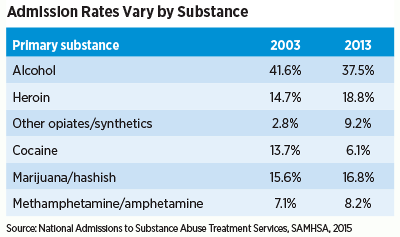A new federal report suggests that admission rates for treatment of certain substance use disorders (SUDs) have changed over recent years. For example, the number of people seeking treatment for alcohol use disorder has been declining, while the number of those seeking treatment for heroin and prescription opioid-related conditions has been dramatically rising.
The study was sponsored by the Substance Abuse and Mental Health Services Administration (SAMHSA), which gathered data from the Treatment Episode Data Set (TEDS), a national dataset containing demographic information on admission rates to publicly funded facilities for substance abuse treatment among individuals aged 12 and older. The current study compared admission rates for five specific substance use disorders between 2003 and 2013.
The results showed that, overall, the number of admissions reported among people aged 12 and older dropped slightly, from 1,865,145 admissions in 2003 to 1,683,451 in 2013.
Though treatment for alcohol use disorders continues to be one of the main reasons why people seek treatment for SUD, admission rates dropped from 41.6 percent in 2003 to 37.5 percent in 2013.
In contrast, admission rates for treatment of various forms of opioid use disorders increased during this period. The proportion of admissions associated primarily with non-heroin opioid use—including prescription painkillers such as hydrocodone and oxycodone—more than tripled in the study period, from 2.8 percent in 2003 to 9.2 percent in 2013. The proportion of admissions primarily associated with heroin jumped from 14.7 percent in 2003 to 18.8 percent in 2013.
Admission rates for treatment of marijuana use increased slightly, from 15.6 percent in 2003 to 16.8 percent in 2013, as did admission rates for methamphetamine and amphetamine use—they rose from 7.1 percent to 8.2 percent between 2003 and 2013.
The proportion of admissions associated with cocaine use (including crack use) declined from 13.7 percent in 2003 to 6.1 percent in 2013.
“Time and again, research has demonstrated that treatment helps people with substance use disorders to regain their lives,” said SAMHSA Acting Administrator Kana Enomoto, M.A., in a press release. “We need to encourage people to seek help. Treatment works. People recover.”
Petros Levounis, M.D., M.A., chair of psychiatry at Rutgers New Jersey Medical School, commented that one of the most striking findings of the study was that heroin admissions were fairly steady from 2003 to 2012, fluctuating between 13 and 16 percent of all admissions. “However, the proportion of heroin admissions jumped to 19 percent in 2013,” Levounis told Psychiatric News. “It seems that more and more people who got addicted to prescription pills in the first decade of the new millennium are now entering the world of intravenous heroin—which is exactly what we see in our everyday clinical practice.”
In response to the high rates of opioid use in the United States over the past decade, SAMHSA is working to broaden awareness about the benefits of treatment for heroin use and illicit use of prescription opioid-derived painkillers. One therapy is medication assisted treatment—a combination of behavioral therapy and medications to treat substance use disorders—which has been shown to help people move toward recovery.
“Whether people are struggling with alcohol, prescription drugs, or illicit substances, seeking help is a critical step toward achieving recovery,” said Enomoto. “As with other life-threatening conditions, this step can be the difference between life and death.” ■
“Treatment Episode Data Set (TEDS) 2003-2013” can be accessed
here.

